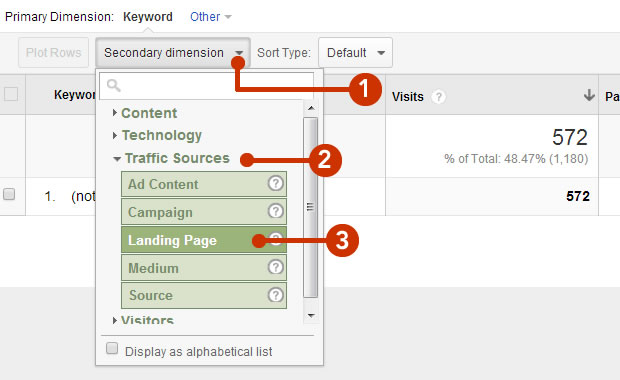Maximize Your Reporting with Secondary Dimension in Google Analytics
Maximize Your Reporting with Secondary Dimension in Google Analytics
Blog Article
Enhance Your Data Analysis Utilizing Additional Dimension in Google Analytics
Discovering the abilities of secondary measurements in Google Analytics opens a world of opportunities for refining data analysis. The ability to dissect information further beyond the surface area level offers a nuanced sight that can form strategic choices. By layering additional dimensions onto key information sets, a more complex story arises, clarifying individual communications and performance indications. This vibrant method to information assessment holds the crucial to opening surprise patterns and fads that could change exactly how companies interpret their electronic footprint.
Understanding Secondary Measurements
Second measurements in Google Analytics refer to extra criteria that can be included to the key measurement, permitting for a more in-depth analysis of information (Secondary Dimension in Google Analytics). By incorporating secondary dimensions, analysts can segment and filter data to discover patterns, trends, and relationships that could not be apparent when looking at the data as a whole.

Benefits of Using Additional Dimensions
When evaluating data in Google Analytics, the application of additional dimensions supplies vital understandings right into customer actions and performance metrics. By adding a secondary dimension to your key information, you can delve much deeper into the qualities of your internet site visitors and their communications. Among the key advantages of using secondary dimensions is the capability to segment and contrast data better. This segmentation allows you to recognize just how various variables, such as demographics or traffic sources, influence individual actions and conversions (Secondary Dimension in Google Analytics).
Furthermore, additional dimensions boost the context of your main information, supplying a much more detailed view of user involvement and efficiency metrics. On the whole, the usage of additional dimensions in Google Analytics can considerably improve the deepness and quality of your information evaluation, leading to more enlightened decision-making and boosted results.
Exactly How to Include Second Dimensions
By integrating second dimensions in Google Analytics, individuals can gain deeper insights into their data evaluation procedure, allowing for even more extensive assessment of customer behavior and efficiency metrics. Including second dimensions is a straightforward process that can significantly boost the depth of evaluation. As soon as in the record, locate the "Additional dimension" tab over the information table.
Analyzing Information With Additional Dimensions
Making use of secondary measurements in information evaluation gives an extra extensive understanding of individual habits and performance metrics. By including an additional measurement to your main see data embeded in Google Analytics, you can dig deeper into the qualities of your site site visitors and their communications. Incorporating the main measurement of 'source/medium' with the second measurement of 'landing page' can disclose which particular pages are attracting website traffic from various sources, helping you optimize these web pages for better engagement.

Fundamentally, examining information with secondary measurements empowers you to gain important understandings into customer behavior, identify patterns, and make notified decisions to improve the performance of your digital buildings.
Ideal Practices for Second Measurements
In information evaluation, integrating secondary measurements efficiently can dramatically improve the deepness of insights originated from metrics and customer behavior patterns. When making use of secondary measurements in Google Analytics or any other logical tool, it is vital to abide by best techniques to ensure the accuracy and relevance of the information evaluation.
One key finest technique is to very carefully pick additional measurements that complement the key dimension being analyzed. Choosing second dimensions that provide added context or additional segmentation can supply a much more comprehensive understanding of the information. It is also important to prevent overcomplicating the evaluation by including too lots of secondary measurements, which might lead to complication or dilution of insights.
In addition, it is a good idea to try out different mixes of main and secondary measurements to uncover new correlations and patterns. Frequently assessing and refining the selection of secondary dimensions based upon the details goals of the evaluation can bring about more workable insights. By following these ideal methods, data analysts can utilize additional measurements successfully to boost the total data analysis process and decision-making capabilities.
Final Thought
To conclude, including secondary dimensions in Google Analytics is vital for a comprehensive data evaluation click resources strategy. By leveraging secondary measurements together with main ones, experts and marketers can uncover valuable understandings and relationships that can inform decision-making and maximize electronic advertising and marketing strategies. Comprehending exactly how to successfully use second measurements and following finest techniques will enable specialists to draw out meaningful information and improve their general performance metrics.
Secondary dimensions in Google Analytics refer to added specifications that can be added to the key dimension, enabling for an extra comprehensive analysis of information. By integrating additional measurements, experts can hop over to these guys segment and filter information to uncover patterns, patterns, and connections that might not be noticeable when looking at the information as a whole. Incorporating the primary measurement of 'source/medium' with the secondary measurement of 'landing web page' can reveal which particular web pages are bring in website traffic from different sources, helping you enhance these pages for much better interaction.
One trick best method is to carefully select additional measurements that complement the key dimension being analyzed. By adhering to these best practices, information experts can take advantage of additional dimensions efficiently to boost the overall data evaluation process and decision-making capacities.
Report this page